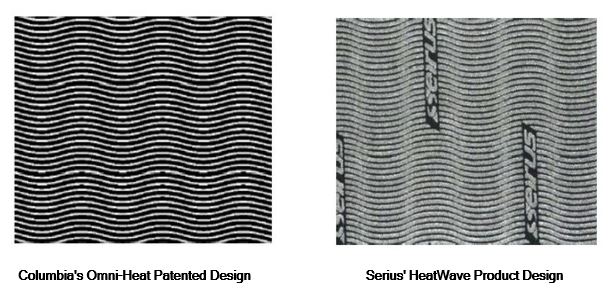To Label Or Not To Label: A Pending Case May Change The Scope Of Design Patent Protection
For decades it was understood that design patent infringement could not be avoided by simply adding a trademark to a patented design. See L.A. Gear, Inc. v. Thom McAn Shoe Co., 988 F.2d 1117, 1125-26 (Fed. Cir. 1993). That line is blurring as Columbia Sportswear N. Am., Inc. v. Seirus Innovative Accessories, Inc returns to the U.S. Court of Appeals for the Federal Circuit. Columbia Sportswear N. Am., Inc. v. Seirus Innovative Accessories, 3:15-CV-00064 (September 22, 2021).
On January 12, 2015, Columbia Sportswear (“Columbia”) asserted their D657,093 design patent against Seirus Innovative Accessories (“Seirus”) by filing an infringement lawsuit in the District of Oregon. Columbia’s design patent covers their heat reflective Omni-Heat® material pattern which they use on a variety of products, e.g., boots, hats, or coats. In the lawsuit Columbia alleged, in part, that Seirus’s HeatWave pattern infringed their patented design. Seirus disagreed, arguing that the addition of their trademark that broke up the wave pattern should also be considered in any infringement analysis. Seirus further noted variations in their pattern with respect to the spacing, size, and orientation of the waves as compared to the patented design. See comparison of designs, below:
The U.S. District Court for the District of Oregon initially granted summary judgement in favor of Columbia Sportwear, finding infringement because “even the most discerning customer would be hard pressed to notice the differences between Seirus’s HeatWave design and Columbia’s patented design.” Columbia Sportswear N. Am., Inc. v. Seirus Innovative Accessories, 202 F. Supp. 3d 1186 (D. Or. 2016), rev’d and remanded sub nom. Columbia Sportswear N. Am., Inc. v. Seirus Innovative Accessories, Inc., 942 F.3d 1119 (Fed. Cir. 2019). In so doing, the District Court declined to consider the effect of the Seirus trademark. Id. Seirus subsequently appealed to the Federal Circuit. After reviewing the case, the Federal Circuit disagreed and held that the District Court should have considered the effect of the Seirus trademark on the overall impression of an ordinary observer. Columbia Sportswear N. Am., Inc. v. Seirus Innovative Accessories, Inc., 942 F.3d 1119, 1130 (Fed. Cir. 2019). The Federal Circuit differentiated the current Columbia case from L.A. Gear. In L.A. Gear the parties did not dispute that the designs were similar and had admitted to copying. The Federal Circuit noted that nothing in L.A. Gear “prohibit[ed] the fact finder from considering an ornamental logo, its placement, and its appearance as one among the other potential differences between a patented design and an accused one.” Id. at 1131 (emphasis original). The Federal Circuit remanded the case back to the District Court for consideration of the design as a whole, including the presence of the Seirus trademark. Id.
On August 6, 2021, the jury returned a verdict in the District Court for the Southern District of California and found that Seirus did not infringe after considering the effect of the Seirus trademark.
In light of this outcome, many practitioners are concerned that the Federal Circuit has opened a “back door” for competitors to avoid design patent infringement by simply placing their trademark or label on an otherwise infringing product. Others believe that the Federal Circuit, in differentiating the Columbia case from L.A. Gear, clearly indicated that a trademark is merely another factor to be considered.
Columbia Sportswear has since appealed the jury verdict, and the Federal Circuit will get a second chance to clarify these issues when the case returns to their docket.


